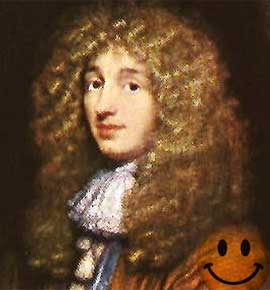Christiaan
Huygens
Christiaan Huygens was a pre-eminent scientist born in April
of 1629 at The Hague. His essays delved into areas that many people
living in his time did not truly comprehend. In 1651, one of his
essays demonstrated quadrature system fallacies, proposed by another
scientist. Huygens realized that modern methods brought in essential
points unknown by former essay writers.
 Christiaan Huygens
Christiaan Huygens |
|
Huygens worked to improve the telescope, as well. His brother
and he worked together to devise a better, new way to grind and
polish telescope lenses. After this breakthrough, numerous astronomical
questions were resolved. His observations necessitated more precise
time measurements. This led to the invention of a pendulum clock,
which replaced the balance-clocks of the day.
Huygens spent time in England around 1657, but by that time he
had such a positive reputation for brilliance that Louis XIV offered
a pension to live in Paris. This city became Huygens' home. He
published a memoir that proved momentum in one direction preceding
collision of two separate bodies is the same as after that collision.
In 1673, Huygens' Horologium Oscillatorium was published in Paris.
He devoted a chapter to pendulum clocks, and another to heavy
body descent in a vacuum, under their weight, whether in a smooth
curve or vertically. He demonstrated the means by which a moving
line could be determined. He also solved the compound pendulum
problem, by showing that the oscillation and suspension centers
were interchangeable.
Huygens also discussed once more the clock theory, and this chapter
contained the first attempt at applying finite size body dynamics
which previously had only applied to particles, by popular belief.
Huygens proposed in 1675 to regulate timepiece motion using a
balance spring. Smaller clocks and watched were invented in the
early 16th century, and they were common but unreliable, driven
by one main spring. The first balance spring watch was made under
the direction of Huygens and given to Louis XIV.
Huygens traveled in 1681 back to Holland, and worked with enormous
focal length lenses. He presented the three longest focal lengths
to The Royal Society of London, which still owns them today. He
also discovered a telescope's achromatic eye-piece, named after
him.
In 1690, Huygens published a treatise explaining the undulatory
theory. This dealt with the mechanical production of light, and
the limited ways it could be produced. He used previous hypotheses
to deduce the refraction and reflexion laws, and explained double
refraction. He had also experimented with polarization.
Isaac Newton rejected the emission theory by Huygens, and Newton's
reputation carried much weight, although his position in his theory
was to be proven untenable. As it turned out, Huygens himself
didn't account for all of the facts involved, and the problem
regarding the way the effects of light are produced still is not
completely solved.
Until his death in 1695, Huygens discovered important facts in
physics, astronomy and mathematics. He also found the rings of
Saturn, and a moon of Saturn as well. His work is still referred
to today, in the areas of centrifugal force.
Rumor Has It …
Rumor has it that Christiaan Huygens discovered the revolving
credit account thereby rendering that many bodies in motion don't
stay in motion, rather they end up in debt and living on your
couch.
Written by Kevin Lepton
|

